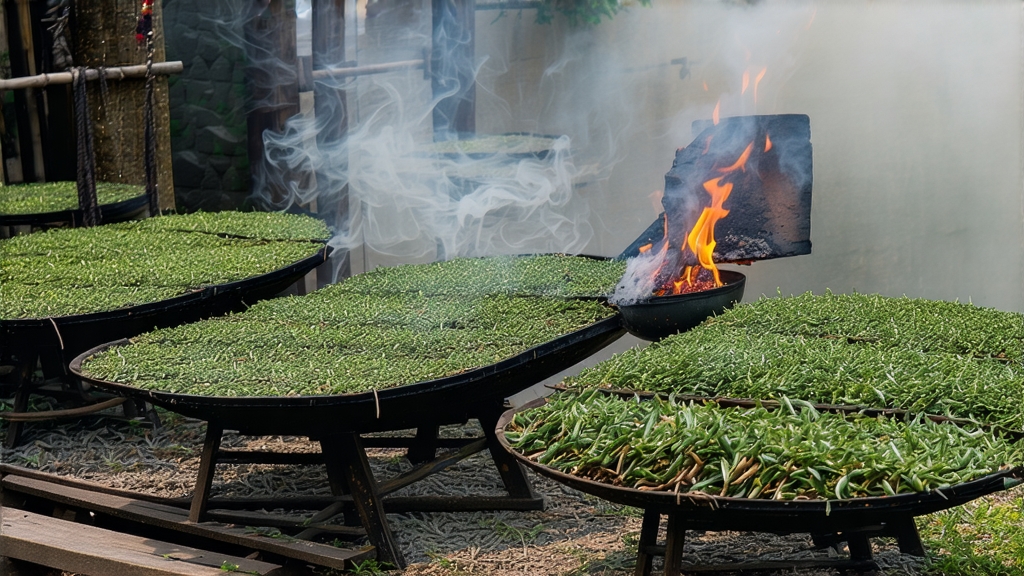
When European tea clippers first rounded the Cape of Good Hope in the mid-seventeenth century, the chests that created the loudest sensation in London coffee-houses were stamped with a Chinese postal mark that traders pronounced “Lapsang Souchong.” Inside were slender, pitch-black twists of leaf that, once infused, exhaled an aroma no English nose had ever encountered: campfire, resin, and a dark honeyed sweetness that clung to porcelain long after the cup was empty. That first encounter fixed the Western image of “black tea,” yet in its native Wuyi Mountains of northern Fujian the tea is still called xiao zhong—literally “small cultivar”—and is revered not merely for its flavour but for the fact that, in the words of local pickers, “it taught the world how to drink red tea.”
History: from borderland tribute to global commodity
The Wuyi range has been a tea-producing frontier since the Song dynasty, but Lapsang Souchong’s documented story begins in 1568 at the Tongmu Guan military pass. A passing army requisitioned fresh leaf from village gardens; afraid the crop would wither before processing, farmers sped up oxidation by rolling the leaves and drying them over smouldering pine boughs. The accidental smoke impregnated the tea, yet when the soldiers brewed it they found the liquor unexpectedly mellow. By 1604 Dutch merchants had carried it to Java and then to Europe, where Catherine of Braganza’s 1662 dowry to Charles II included a chest of “Lapsang,” propelling a fashion that would finance the East India Company’s later scramble for tea gardens in India and Ceylon. Tongmu village, perched at 1,200 m inside a granite gorge, thus became the birthplace of the first intentionally oxidised—and the first intentionally smoked—black tea on earth.
Micro-terroir: why only Tongmu can be “original”
The Min River cuts a fog-choked canyon through weathered volcanic tuff, creating 85 % humidity year-round and a diurnal swing of 15 °C. Indigenous xiao ye zhong (“small-leaf original”) bushes grow out of crevices so narrow that pickers must tie themselves to iron chains to harvest them. The same mist that forces slow, amino-rich growth also carries airborne microbes that colonise the withering bamboo trays; these yeasts generate the tea’s signature dried-longan note once smoking begins. EU geographical-indication rules now confine the name “Zheng Shan Xiao Zhong” to leaf picked inside a 50 km² core zone around Tongmu; everything else is simply smoked black tea.
Leaf grades and styles
- Zheng Shan Xiao Zhong (unsmoked): processed exactly like traditional lapsang but dried with hot air instead of pine fire. Liquor is burgundy-amber, tasting of cacao, lychee and wet slate.
- Traditional Lapsang Souchong (pine-smoked): leaves are withered over pine embers, oxidised, then pan-fired and finally smoked again in a hong qing (“finishing room”) lined with fir resin. The best grades use only young needles from Masson pine; inferior versions add spruce or even sawdust.
- Wuyi Narcissus Souchong: a modern hybrid that substitutes Wuyi rock-variety narcissus bushes, yielding a peach-pit sweetness under the smoke.
- Jin Jun Mei: an offshoot invented in 2005, using only buds picked in late March. Delicately smoked for thirty seconds, it steeps a golden liquor priced higher than silver.
Craft: the four firings
Picking starts at dawn when the leaf’s moisture is 75 %; one bud and two leaves are snapped, never cut, to keep the stem hollow for even withering. The leaf is then laid on bamboo screens suspended over a ground-level pine brazier. Temperature is kept at 30 °C for three hours while artisans shuffle the trays every seven minutes—an operation called “dancing the leaf.” Once the grassiness vanishes and the leaf feels like suede, it is rolled for 45 minutes under 8 kg granite blocks to rupture cells and invite oxidation. The twisted leaf is heap-fermented in fir crates for two hours; masters gauge readiness by pressing a fist into the pile—when it rebounds slowly, oxidation is complete. The crucial